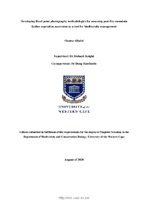| dc.contributor.advisor | Knight, Richard | |
| dc.contributor.advisor | Harebottle, Doug | |
| dc.contributor.author | Alkalei, Osama | |
| dc.date.accessioned | 2021-03-25T13:02:37Z | |
| dc.date.available | 2021-03-25T13:02:37Z | |
| dc.date.issued | 2020 | |
| dc.identifier.uri | http://hdl.handle.net/11394/8058 | |
| dc.description | Magister Scientiae (Biodiversity and Conservation Biology) - MSc (Biodiv and Cons Biol) | en_US |
| dc.description.abstract | Areas of high biodiversity and complex species assemblages are often difficult to manage and to set up meaningful monitoring and evaluations programmes. Mountain Fynbos is such an ecosystem and in the Cape of Good Hope (part of the Table Mountain National Park) plant biodiversity over the last five decades has been in decline. The reasons are difficult to speculate since large herbivores, altered fire regimes and even climate change could be contributors to this decline which has been quantified using fixed quadrats and standard cover-abundance estimates based on a Braun-Blanquet methodology. To provide more detailed data that has more resolution in terms of identifying ecological processes, Fixed-Point Repeat Photography has been presented as a management “solution”. However, photography remains a difficult method to standardize subjects and has certain operational limitations. | en_US |
| dc.language.iso | en | en_US |
| dc.publisher | University of Western Cape | en_US |
| dc.subject | Biodiversity management | en_US |
| dc.subject | Change detection | en_US |
| dc.subject | Fixed-point repeat photography | en_US |
| dc.subject | High-resolution images | en_US |
| dc.subject | Mountain Fynbos | en_US |
| dc.subject | Post-fire succession | en_US |
| dc.title | Developing fixed-point photography methodologies for assessing post-fire mountain fynbos vegetation succession as a tool for biodiversity management | en_US |
| dc.rights.holder | University of Western Cape | en_US |

